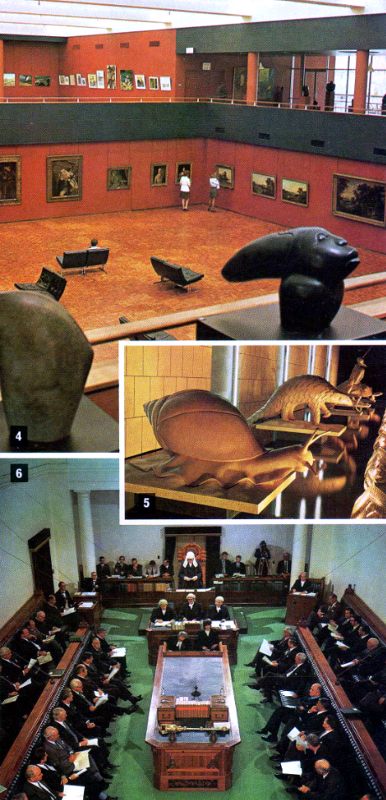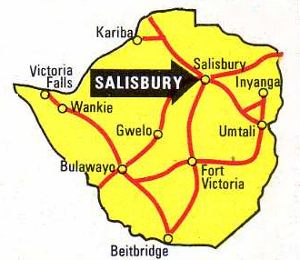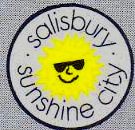Photos: Lovely Salisbury, capital of Rhodesia
(005875.811-:E-000062.43:N-AC:R-SU:C-30:V)
[Here is a very lovely collection of photos of Salisbury. This is the city I was born in. Horse racing was a big thing in Rhodesia, along with betting on the races. This is what Whites did to African bush, where previously, there was nothing. Jan]Rhodesia’s Capital – Salisbury
Salisbury was born on September 13, 1890, when the Pioneer Column raised the flag after their long and
hazardous journey from what was then Bechuanaland. The site of their rough fort is now marked by Cecil Square in the centre of the city (upper left on cover picture of this brochure).
The spacious, modern city that has risen from such recent and humble origins is the capital of Rhodesia, has a population of half a million (all races) and extends over 536 square kilometres. Here the visitor may enjoy all the comforts and amenities expected of a modern city.
One of the glories of Salisbury, softening the hard lines of high-rise modern buildings, is the display of colour afforded by the flowering trees which line the streets. In September and October the purple jacarandas give their name to the city’s annual festival held in early October when a street procession (Below: inset 1), and cultural and sporting events provide a concentrated programme.
The jacarandas are followed by the brilliant flamboyants (main picture left), the spathodias, bauhinias and many others. More natural colour may be seen in the Cecil Square flower market (Below inset 2), where vivid local and exotic blooms provide an extensive, ever-changing display.
The visitors shopping interest will naturally focus on the many curio shops. Goods in glowing Rhodesian copper (Below: inset 3), and animal skins are available, and some shops specialise in products made by African villagers in local natural materials. Sculptures in wood and soapstone of a very high quality are available at bargain prices.
As the capital, Salisbury is the administrative, judicial and communications centre of the country. In the Rhodesian Parliament, the visitor may watch the legislators at work (Below: inset 6) and, when the House is not sitting, conducted tours of the building with its historic possessions are permitted.
Salisbury is also the home of the country’s National Gallery, a modern art centre (Below: inset 4) with a permanent collection covering many periods of historical art. The Gallery’s workshop school of African art has received world-wide acclaim and some of its remarkable work is available for sale.
The history of man and animals in Mashonaland, the highveld province of Rhodesia in which Salisbury is situated, may be seen in lifelike displays at the Queen Victoria Museum, an institution that has as contemporary an approach to its subject as the giant sculptures which form part of its facade (Below: inset 5)
Salisbury at night provides the visitor with a choice of entertainment to round off a day’s sightseeing. Night-clubs offer dancing, dinner and cabaret (Below: inset 1) for those who wish to stay up late.
For those who prefer to dine, there is a large choice of restaurants (Below:inset 2) offering the cuisine of many lands and of course. Rhodesian steaks. By world standards eating out in Rhodesia is cheap and the local wines, though young, are very reasonably priced.
Regular theatre, both visiting professional and local semi-professional, operates throughout the year. There is a regular ballot season (Below:inset 3) and visiting celebrity musicians include Salisbury on their Southern African circuit.
There is, of course, a choice of modern cinemas and for the stay-at- homes hotels have television, some providing sets in every bedroom, others with special lounges.
At week-ends the sporting Rhodesian and visitor come into their own. At Borrowdale Park (main picture right), the racegoer is provided with amenities comparable with any in Southern Africa. Due to Salisbury’s superb climate, racing takes place throughout the year. Another form of horse-racing that has a considerable folic wing, is trotting, (Below:inset 7) an exciting and unusual sport.
Both Africans and Europeans support a vigorous football league and hard fought matches attract thousands (Below: inset 6). Rugby also has a large following, and club matches are of a high standard with visiting international sides providing special excitement during the season.
With its abundance of open spaces Salisbury offers a choice of over a dozen golf courses, some within sight
of the city centre’s high-rise buildings (Below: inset 5). Visitors are welcome and will find the green fees to be most reasonable.
Salisbury recently opened an international standard motor-racing circuit at Donnybrook on the outskirts of the city. Here racing, from Formula 1 to motor cycles, takes place regularly during the year (Below: inset 4). At other tracks the exciting sport of motor cycle scrambling takes place during most weekends.
Thirty-five kilometres west of the city is Lake Mcllwaine, the country’s third largest lake. and. like all the others, man-made. This fifty-seven square kilometres stretch of water and its shoreline form the Robert Mcllwaine National Park, which has been developed as a water playground.
Around its shores, yacht and motor boat clubs provide facilities for members and visitors. An hotel overlooks the lake and there are tea-rooms which provide refreshments for the casual visitor. Fishing here is excellent, particularly for bream and tiger fish.
On the road to the park from the city is a private lion and cheetah park, where the photographer will find an opportunity of making close studies of lion (Below: inset 1). cheetah and other species kept here.
The north bank of Lake Mcllwaine has been developed to provide re creation facilities, including caravaning and camping (Below: inset 5). On the southern shore, however, the natural surroundings have been protected and an extensive game park established. On a network of game-viewing roads the visitor may see kudu (main picture right) white rhino (Below: inset 2), zebra, ostrich, sable, impala, wildebeeste and eland.
The combination of woodland and lakeside environments provides an unusually high population of birds, and some ornithologists have made counts of over 200 species in a single day. For the nature lover who specialises in trees, there is an arboretum situated near the massive Hunyani Poort dam. The spillway here is a spectacular sight in the rainy season as the overflowing water – cascades into the river below.
Evidence of an earlier occupation of the area may be seen in the rock paintings, some dating back hundreds of years, which are to be found on many sheltered rock faces within the park (Below: inset 3).
In the game park and on the northern shore, are National Park caravan and camping facilities. Within the game park are chalets, and situated at certain scenic points are fully serviced lodges which may be rented (Below: inset 4). For those who wish to explore the lake, boats may be hired, with experienced coxwains who know the area well.
Beyond the city area there are drives which will take the visitor through a variety of Rhodesian highveld scenery.
One of these drives passes through the attractive Mazoe Valley. 40 kilometres from the city, where vast citrus orchards extend over 21 square kilometres (Below: inset 1). Fruit from these orchards may be purchased from a kiosk at Mazoe Dam where the road cuts through the Iron Mask range of hills which form one side of the valley.
Twelve kilometres south of Salisbury is an area of granite boulders which vividly displays one of the most memorable features of the Rhodesian landscape — its rock formations. Sculptured by rain and wind, some formations have acquired fantastic balancing shapes (Below: inset 2). On the sheltered faces of some rocks are ancient paintings executed by former inhabitants of Rhodesia.
Ewanrigg National Park, 35 kilometres from Salisbury, is a treasure house of colourful aloes and ancient palm-like cycads — seen at their best in July and August but an impressive sight at any time of the year. There is also a large collection of cacti from ail over the world and many exotic trees. The 24 hectares of landscaped gardens are set within 283 hectares of natural veld (Below :inset 3).
More detailed information on the area described in this brochure is available from the Salisbury Publicity Association, P.O. Box 1483, Salisbury.
For information on other areas of tourist interest in Rhodesia please contact the Rhodesia National Tourist Board, P.O. Box 8052, Causeway, Salisbury.
End
Source: Rhodesia Calls January – February 1975 made available by Denise Taylor. Thanks Denise.
Source: https://rhodesianheritage.blogspot.com/2013/03/rhodesias-capital-salisbury.html
Jan‘s Advertisement
White Shop: Fire Force: A Troopers War In The Rhodesian Light Infantry
This is the best book Ive read about Rhodesia which describes the life of a young soldier who is in the Fire force. These guys were called into battle several times a day and the fighting was hectic. This book is very well written and you never get bored.
White Shop: Fire Force: A Troopers War In The Rhodesian Light Infantry
This is the best book Ive read about Rhodesia which describes the life of a young soldier who is in the Fire force. These guys were called into battle several times a day and the fighting was hectic. This book is very well written and you never get bored.
Jan‘s Advertisement
Video: Only Jews have a direct telephone line to God and they speak to him!
At first you might think this is really just about religion, but in fact, this discussion is not about religion. This is a discussion about other things.
Video: Only Jews have a direct telephone line to God and they speak to him!
At first you might think this is really just about religion, but in fact, this discussion is not about religion. This is a discussion about other things.
Jan‘s Advertisement
Get a Free PDF Book: The Boer Fight for Freedom (1902)
Here is a really old, historical book written shortly after the 2nd Anglo Boer War. It is 634 pages long and includes photos, illustrations and maps. This book was written by an Irishman who was a member of the British House of Commons. He was so OUTRAGED by this war started by the British that he resigned from his position in 1899.
Get a Free PDF Book: The Boer Fight for Freedom (1902)
Here is a really old, historical book written shortly after the 2nd Anglo Boer War. It is 634 pages long and includes photos, illustrations and maps. This book was written by an Irishman who was a member of the British House of Commons. He was so OUTRAGED by this war started by the British that he resigned from his position in 1899.











